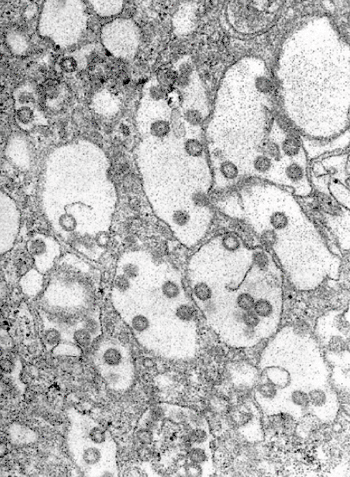NanoTrap Particles Enhance Rift Valley Fever Virus Detection
By LabMedica International staff writers
Posted on 25 Jul 2013
There is a crucial need for rapid detection and identification of the Rift Valley fever virus (RVFV) as this emerging infectious agent is highly pathogenic. Posted on 25 Jul 2013
The diagnosis of RVFV is restricted to a small number of laboratories and this limitation has led to some delay in diagnostics associated with virus isolation and identification techniques.

Image: Electron micrograph of Rift Valley fever virus (Photo courtesy of Dr. Fred Murphy, CDC).
Scientists at the George Mason University (Manassas, VA, USA) working with a colleague from a commercial company, used a novel sample preparation technology to enhance the detection of RVFV. This technology consists of homogenous hydrogel particles of about 800 nm in size that have a shell made of various polymers.
The team screened NanoTrap particles (Ceres Nanosciences; Manassas, VA, USA) to enhance viral detection and found that one particle, NT53, was the most efficient at RVFV capture as demonstrated by both quantitative reverse transcriptase polymerase chain reaction (qRT-PCR) and plaque assays. Importantly, NT53 capture of RVFV resulted in greater than 100-fold enrichment from low viral titers when other diagnostics assays may produce false negatives. NT53 was also capable of capturing and enhancing RVFV detection from serum samples.
Importantly, the RVFV that was inactivated through either detergent or heat treatment, was still bound to NT53, indicating the ability to use NanoTrap particles for viral capture prior to transport to a Biosafety Level 2 (BSL-2) environment. Incubation of RVFV samples with NT53 also resulted in increased viral stability as demonstrated through preservation of infectivity at elevated temperatures. The NanoTrap particles were also capable of capturing Venezuelan equine encephalitis virus (VEEV) and Human Immunodeficiency virus (HIV) demonstrating the broad applicability of NanoTrap particles for viral diagnostics.
The authors concluded that NanoTrap particles are able to capture and enrich whole viruses. Other commercially available beads can also capture virus, but only NanoTrap particles were capable of protecting the integrity of the virus after inactivation with detergent or exposure to Ribonuclease A (RNase A). Symptoms of RVFV in humans are usually mild and include febrile illness resembling influenza, with a small percentage developing serious clinical manifestations such as retinal lesions, meningoencephalitis, hepatitis, severe hemorrhagic fever, coma, and death. In recent years, an increase in mortality among humans from 2% to 45% has been reported, suggesting evolving mechanisms of virulence and mutations. The study was published on July 4, 2013, in the journal Public Library of Science Neglected Tropical Diseases.
Related Links:
George Mason University
Ceres Nanosciences













